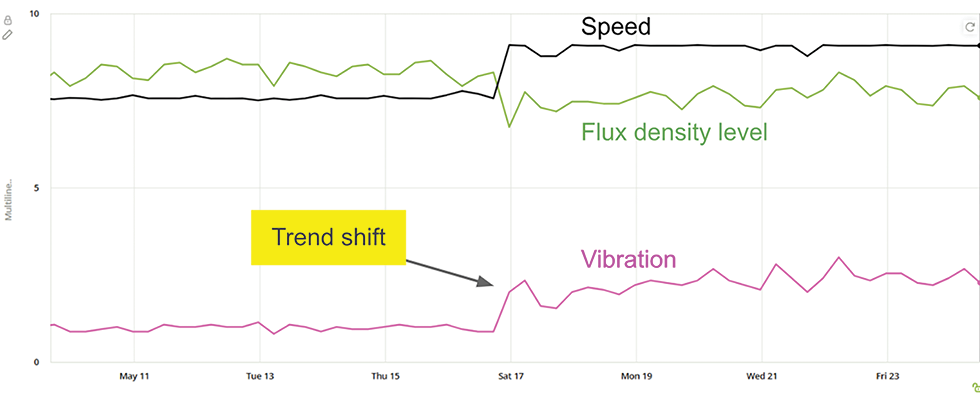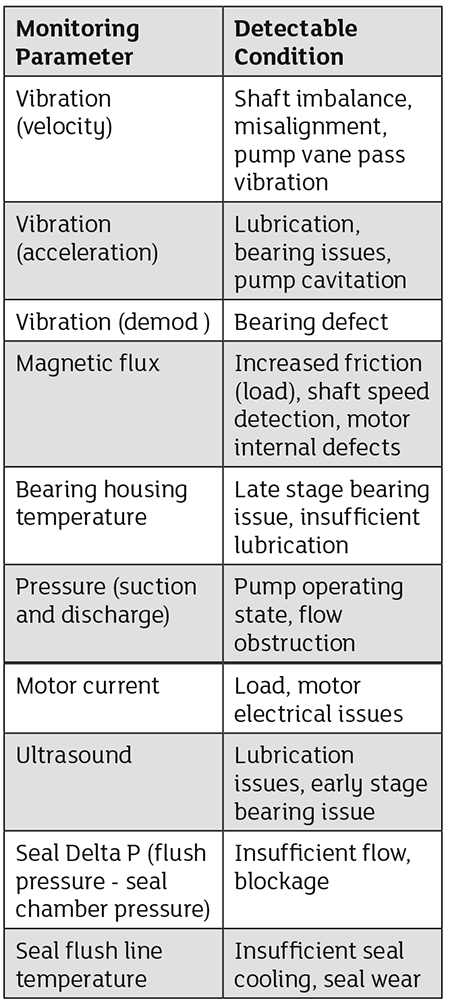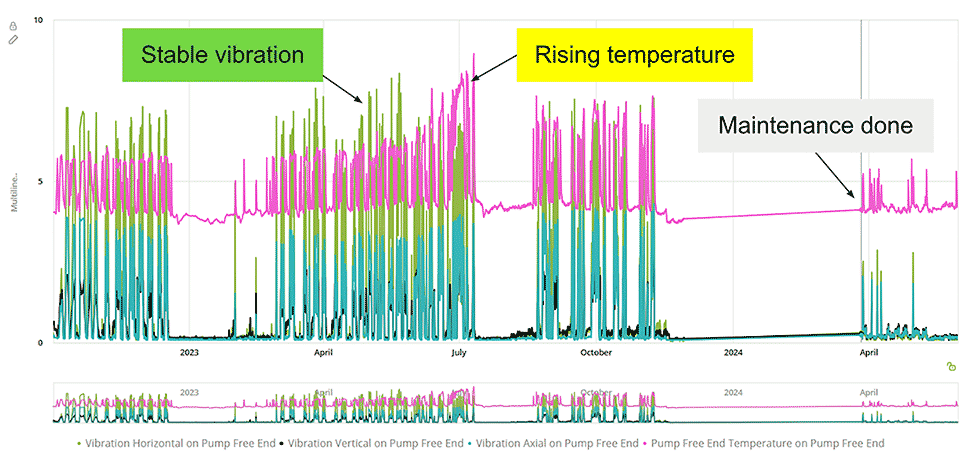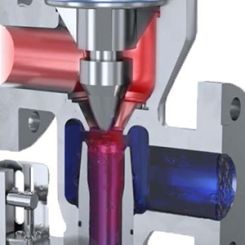
Pump Monitoring in a Data-Rich Era
Pumps are essential rotating machines used across industries—from water treatment and oil and gas to food processing and pharmaceutical manufacturing. Despite their critical role, pumps are often a source of inefficiency, unplanned downtime and maintenance costs due to undetected process issues or improper operation.
Traditionally, vibration analysis has been the primary method for assessing pump condition, focusing on mechanical faults like imbalance, misalignment and bearing wear. However, a vibration-only approach often misses key issues due to several limitations:
- Many failures are process-related (e.g., cavitation, suction blockage, operation outside best efficiency point, etc.), where vibration is a secondary symptom.
- Dynamic operating conditions (varying speed/load) cause shifting baselines, complicating diagnosis without added context.
Multiparameter sensing addresses these gaps by combining low- and high-frequency vibration with measurements like temperature, magnetic flux and process data. This provides a fuller picture of pump health and enables:
- Detection of both mechanical and process-related faults
- Visibility into speed, load, pressure and flow to contextualize vibration
- Smarter, more confident decisions around reliability and maintenance
Multiparameter monitoring goes beyond traditional vibration analysis by delivering the operational context needed to act with confidence.
Why a Broader View of Pump Health Matters
Vibration data alone rarely tells the full story, especially when process conditions fluctuate. Multiparameter monitoring fills that gap by layering in temperature, pressure and magnetic flux for better diagnostic clarity.
Tracking operating state is one of its biggest advantages. On pumps with variable frequency drives (VFDs), speed changes directly affect vibration. Without knowing the running speed, identifying fault frequencies becomes difficult. Speed estimation via magnetic flux enhances vibration analysis dramatically.
Multiparameter data also helps catch problems like dry running, suction blockage or rising seal temperature—issues that do not always show up in vibration early on. These subtle process-related signs can be detected through changes in temperature or pressure before failure occurs.
Finally, combining mechanical and process signals supports better root cause analysis and more targeted corrective action. This means smarter decisions on lubrication, load balancing and service intervals, leading to a more proactive, data-driven reliability program. Image 1 summarizes how different parameters help detect common pump failure modes.

The following case studies highlight how multiparameter pump monitoring provides valuable context for interpreting machine behavior. By combining data streams like vibration, temperature and magnetic flux, these examples show how early-stage issues were uncovered (or false alarms ruled out) that vibration alone may have missed.
Case Study 1: Using Magnetic Flux to Prevent False Alarms
Multiparameter monitoring proved valuable in this case by helping a water treatment facility avoid a false alarm on a vertical pump. A sudden increase in vibration was initially cause for concern, but complementary data from magnetic flux provided the operational context needed to correctly interpret the event.
Magnetic flux sensing is particularly effective for motor-driven pumps, offering real-time insights into:
- Running speed (rotations per minute [rpm])
- Load variations
- Start/stop events
In this instance, a change in process demand caused one pump in a three-pump system to ramp up to full speed. As expected, the increase in speed resulted in a corresponding rise in vibration levels (Image 2). Without additional context, this could have prompted an unnecessary inspection.

By correlating vibration with speed and load information derived from magnetic flux, the monitoring team confirmed that the elevated vibration was consistent with normal operating behavior and not indicative of a developing fault. This helped avoid unneeded downtime and ensured maintenance attention remained focused on truly at-risk assets.
Case Study 2: How Temperature Revealed a Hidden Pump Issue
At a pharmaceutical manufacturing facility, a motor-gearbox-pump assembly was being monitored as part of a predictive maintenance program. Although vibration levels remained stable throughout the period, a gradual and consistent increase in bearing temperature was observed at the pump’s nondrive end.
Because no changes were seen in vibration data, analysts suspected a nonmechanical issue and recommended reviewing operating conditions and checking the gearbox oil quality as a first step.
Following inspection, the maintenance team opted to replace the unit with a spare. After replacement, all monitored parameters, including vibration and bearing temperature, returned to normal. While the root cause of the temperature rise was not conclusively identified, this example highlights the value of monitoring multiple parameters. Had the team relied on vibration alone, the early signs of an issue may have gone unnoticed. In this case, temperature monitoring provided critical insight that triggered timely investigation and resolution.
In pump systems, where flow, load and process conditions can vary widely, relying on vibration data alone often leaves important questions unanswered. Multiparameter sensing, combining inputs like magnetic flux, temperature, pressure and motor current, adds the context needed to explain why vibration is changing, what fault modes may be developing, which components are affected and whether it is a bearing, seal, impeller or shaft.

As illustrated in the real-world examples, integrating multiple data streams enables reliability teams to better distinguish between normal operating changes and true mechanical or hydraulic problems. This holistic approach improves diagnostic accuracy, reduces false alarms and ultimately leads to more proactive, confident and effective maintenance decisions.

